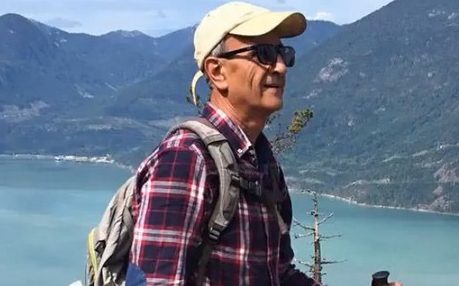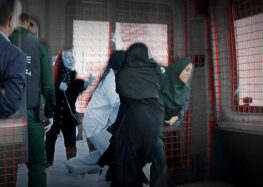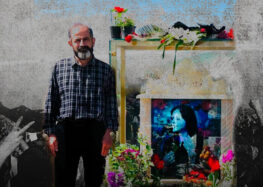Lawyer: IRGC Film of Seyed-Emami’s Prison Cell Does Not Show Act of Suicide
 Film Shows Detainee Visibly Agitated Before Disappearing From Camera’s View
Film Shows Detainee Visibly Agitated Before Disappearing From Camera’s View
A lawyer representing the family of Kavous Seyed-Emami, who died under interrogation in Evin Prison on February 9, 2018, said a film of the detainee’s last living hours does not show him committing suicide.
Payam Derafshan also told the Center for Human Rights in Iran (CHRI) that he and another lawyer hired by the family are investigating the case to determine the cause of death and reason Seyed-Emami was visibly agitated before he died.
“An autopsy was carried out and a burial permit was issued when Mr. Seyed-Emami was buried but for the cause of death, we have to wait for the medical examiner’s final report, which usually takes a month,” Derafshan told CHRI on February 13.
He added: “What does the medical report say about what was in his blood? Did he take medications? We will ask the family if he was taking any medications or not. Unfortunately, the family is not in a suitable mental state right now. We have to do some investigations ourselves and seek help from judicial officials.”
“So far, Mr. Shahriari, the Criminal Court investigator in this case, has been acting well and in our presence, he spoke firmly to some organization and told them that they must hand over the [interrogation] film or else the family would not take the body,” he added. “Mr. Shahriari said he would study the interrogations to see what state Seyed-Emami was in.”
On February 12, the Islamic Revolutionary Guard Corps (IRGC) requested a meeting with an unknown number of lawmakers to show them a film of Seyed-Emami’s last moments.
“The fact that the film was shown to members of Parliament by the IRGC indicates that they were the ones holding him,” Derafshan told CHRI. “They claim the incident happened in Evin Prison. Lawmakers claim that he was being held under good conditions because he was a professor but he could not tolerate it and committed suicide.”
He continued: “However, in the film, we see that he is very anxious and disturbed in his cell. This is the part we are interested in, and we want to know, what did you do to him for him to act that way? From a legal standpoint, if something goes wrong, responsibility lies with the detaining authority and the [State] Prisons Organization. I hope if some people are at fault, they won’t hide behind the state.”
The film does not show the actual act of suicide, Derafshan told CHRI.
“There used to be a hidden camera in his cell which had hygienic services [a toilet] but apparently the [State] Prisons Organization had complained and said that there was no need for the camera to show the toilet. Or maybe their cameras cannot cover the whole area in these kinds of cells,”
He continued: “In the film, he enters the hygienic services’ area. The next day, someone brings breakfast and leaves. The film shows that this person comes back and sees that the breakfast has not been picked up. He opens the door and then calls out for others to come. When they take the body out there is a shirt around the neck. They had to cut the shirt because it had become too tight.”
Derafshan and another lawyer, Arash Keykhosravi, are jointly representing the Seyed-Emami family to seek answers about the death of the 63-year-old Iranian-Canadian, who died in Evin Prison on February 9.
A sociology professor at Tehran’s Imam Sadeq University, Seyed-Emami was also the managing director of the Persian Heritage Wildlife Foundation (PHWF) when he was arrested on January 24, 2018, along with other current and former staff members at the non-governmental organization (NGO).
When the body was delivered to his family on February 9, the authorities claimed he had committed suicide. He was buried near Amaneh Cemetery near Tehran on February 13.
“The moment of suicide is not clear in this film,” said Deputy Parliamentary Speaker Ali Motahari after viewing the film of Seyed-Emami’s cell. “But for seven or eight minutes, he was doing things that could possibly suggest he had the intention to commit suicide.”
The conservative MP said that “more details are necessary” to determine the cause of death.
On February 13, Tehran Prosecutor Abbas Jafari Dowlatabadi accused Seyed-Emami and other current and former PHWF staff members arrested at the same time as the university professor of gathering classified information for US and Israeli intelligence agencies under the guise of research.
Seyed-Emami’s family attorney countered that Dowlatabadi broke the law by making unsubstantiated accusations to the press.
“The prosecutor’s statements are in violation of the law,” Derafshan told CHRI. “The accused should go to court and face charges in a trial before a ruling is made. The law prohibits anyone from accusing people of committing crimes.”
The exact number of people who were detained when Seyed-Emami was arrested is not known but in addition to Seyed-Emami, so far seven other names have been mentioned by Iranian news media: Amir-Hossein Khaleghi, Niloufar Bayani, Sam Rajabi, Morad Tahbaz, Taher Ghadirian, Houman Jowkar and his wife, Sepideh Kashani.
Kaveh Madani, the deputy head of Iran’s Department of Environment (DOE) in charge of international affairs who had reportedly also been detained, posted a video on Twitter on February 12 saying that he had returned to work and thanking people for expressing concern.
But a BBC Persian reporter, Mehdi Parpanchi, said he had information that Madani had recorded the video in his office in the presence, of security agents who then returned him to custody.
*This article was modified on February 16, 2018, to reflect the correct spelling of Payam Derafshan’s name.






